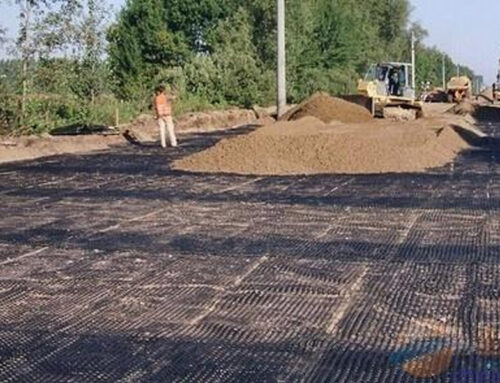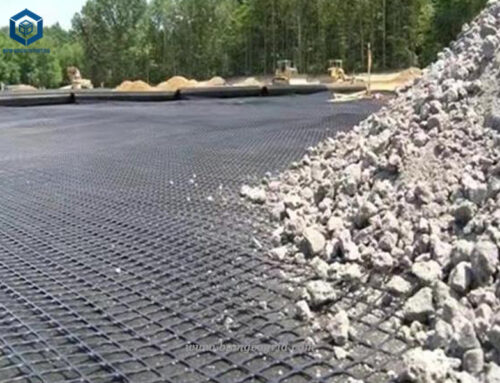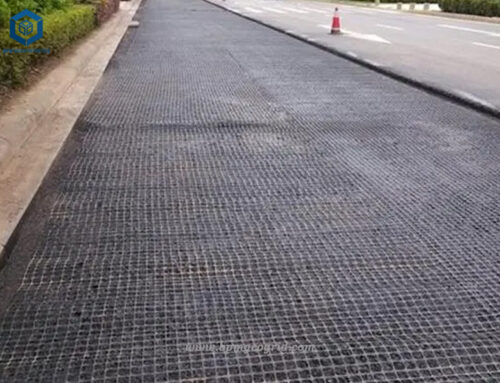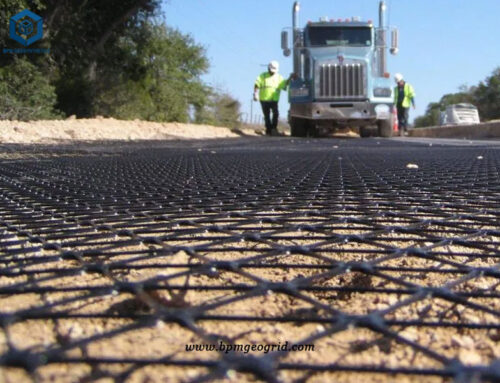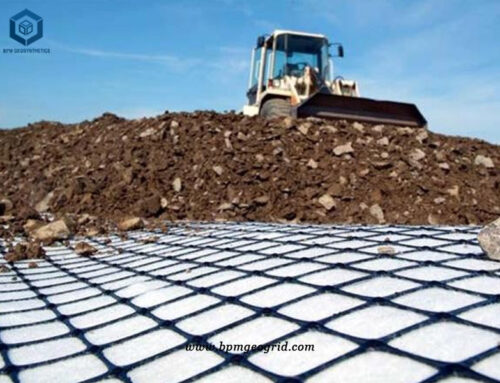Uniaxial plastic geogrid is a kind of high-strength geosynthetic material which is widely used to reinforce or stabilize soils and other materials for subgrade improvement, pavement base reinforcement, or retaining walls, etc. BPM geogrid is made of high-density polyethylene (HDPE) as raw material, extruded into a thin plate and then punched into regular mesh, and then longitudinally stretched. The outstanding advantage of the grid is that the tendency of deformation (creep) under long-term continuous load is small, and the creep strength is much better than the geogrid made of other materials, which plays an important role in improving the service life of the project. Widely used in dams, tunnels, docks, roads, railways, construction and other fields.
Characteristics of Uniaxial Plastic Geogrid
The polymer of plastic uniaxial geogrid is oriented in a linear state and forms a long elliptical network-like integral structure with uniform distribution and high joint strength. This structure has a relatively high tensile strength and rigidity, providing the ideal combination of force bearing and diffusion for the soil.
The outstanding advantage of the one-way uniaxial plastic geogrid is that the tendency of deformation (creep) under long-term continuous load is small, and the creep strength is much better than the geogrid of other materials, which plays an important role in improving the service life of the project.
The occlusion and interlocking action between the grid mesh and the soil constitutes an efficient stress transmission mechanism, so that the local load can be quickly and effectively diffused into the large-area soil, thereby reducing the local failure stress. To improve the service life of the project.



Uniaxial Plastic Geogrid Application
Uniaxial palstic geogrid is mainly used for retaining walls, abutments, steep slope projects, etc.; widely applicable to large-area, long-term bearing roadbed reinforcement. Road, railway subgrade, airport, dock, large cargo and other permanent foundation reinforcement, can effectively distribute the load, improve the bearing capacity and stability of the foundation, prevent breakage and extend life. It can be used in highways, railways and tunnels to cushion external deformation and prevent cracks from leaking. Slope care for roads and railways to prevent landslides and soil erosion.
The retaining wall and the abutment belong to the stressed structure and bear all external loads: active earth pressure, dynamic load on the upper part of the structure, temperature stress, etc., the reinforced material is under a large tension for a long time, and the repeated action of the dynamic load Under the material, the molecular structure of the material is fatigued, its performance is attenuated, and the aging of the grid is accelerated. In order to avoid large deformation of the structure due to the creep of the reinforced material, a one-way plastic geogrid made of high density polyethylene (HDPE) should be selected.
- Uniaxial plastic geogrid is used to reinforce weak foundation: geogrid can rapidly improve foundation bearing capacity, control the development of settlement, and the lateral action of the road base can effectively distribute the load to a wider subbase. Therefore, the thickness of the base layer is reduced, the construction cost is reduced, the construction period is shortened, and the service life is prolonged.
- Uniaxial plastic geogrid is used for reinforced asphalt or cement pavement: geogrid is laid on the bottom of asphalt or cement pavement to reduce the depth of rutting, prolong the fatigue life of pavement, and reduce the thickness of asphalt or cement pavement. save costs.
- Uniaxial plastic geogrid is used to reinforce the embankment dam and the retaining wall: the filling of traditional embankments, especially high embankments, often requires overfilling and the edges of the shoulders are not easily compacted, resulting in rain erosion of the later slopes. The phenomenon of collapse and instability has occurred at the same time. At the same time, it is necessary to use a gentle slope. The floor space is large and the retaining wall has the same problem. The use of geogrid to reinforce the embankment slope or retaining wall can reduce the occupation by one-half. The floor area will prolong the service life and reduce the cost by 20-50%.
- Uniaxial plastic geogrid is used to reinforce rivers and seawalls:.it can be used as a stone cage, and then used together with the grille to prevent the dam from being collapsed by seawater. The stone cage has permeability, which can slow the impact of the waves and prolong the life of the dam. Save manpower and material resources and shorten the construction period.
- Uniaxial plastic geogrid is used to treat landfills. Geogrid is used in combination with other soil synthetic materials to treat landfills, which can effectively solve problems such as uneven settlement of foundations and derivative gas emissions, and can maximize the problem. The storage capacity of the landfill.
- The special purpose of Uniaxial plastic geogrid. low temperature resistance. The low-temperature geogrid of Liantuo Company has been subjected to repeated hot and cold cycles at -45°C—50°C for 200 times, and all performance indexes have met the requirements. It has passed the test of Qinghai-Tibet Railway and is suitable for less frozen soil in the north. , rich frozen soil, high frozen soil, bad soil.
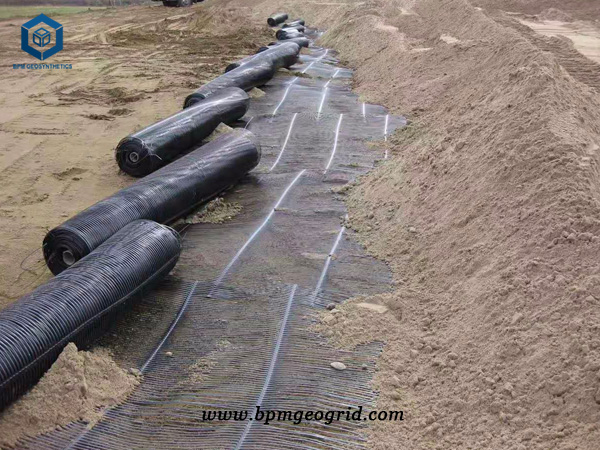


Construction method of uniaxial plastic geogrid used for reinforced earth retaining walls
1. Set the foundation and carry out the construction according to the designed wall system. When prefabricated reinforced concrete panels are used, the thickness is generally 12-15cm supported on the precast concrete foundation. The width is not more than 30cm, the thickness is not less than 20cm, and the buried depth is not less than 60cm to prevent the frostbite of the foundation.
2. Level the wall foundation and excavate and level it according to the design requirements. The soft soil needs to be compacted or replaced, compacted to the required density and should be slightly above the wall surface.
3. The ribs are laid, and the main strength direction of the ribs should be perpendicular to the wall surface and fixed by pins.
4. Wall filling, mechanical filling, the distance between the wheel and the reinforcement should be at least 15cm. After compaction, the layer of soil is about 20-15 cm thick.
5. When the wall is constructed, the geotextile should be covered on the wall to prevent the filling of the soil.
About BPM
BPM manufactures and supplies many types of effective and state of the art geogrid, geomembrane, geotextile and geosynthetics products to over 36 countries. Our main innovative, high quality geosynthetics products include geomembrane, geotextiles, geocell, geosynthetic clay liners (GCLs), drainage boards, etc. BPM brand brand high quality geosynthetic products had been certificated by the ISO9001, ISO14001,OHSAS18001 Soncap, SASO and BV, SGS and Intertek, etc.

